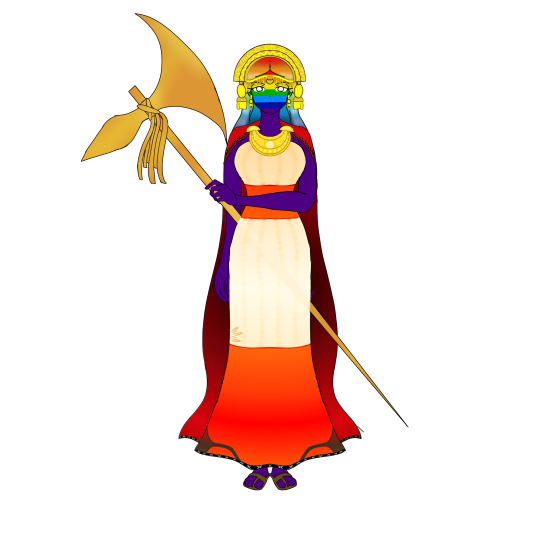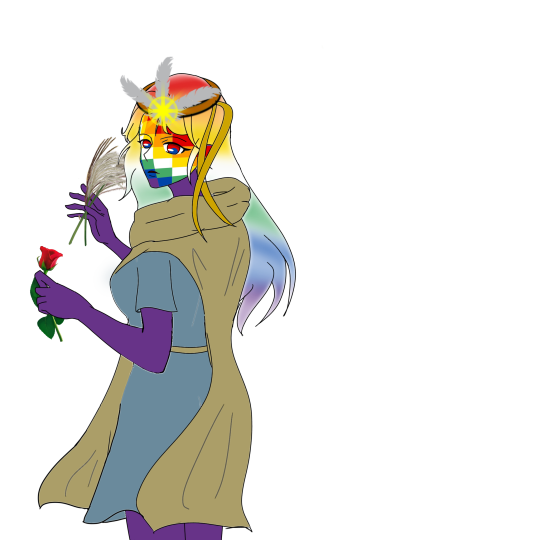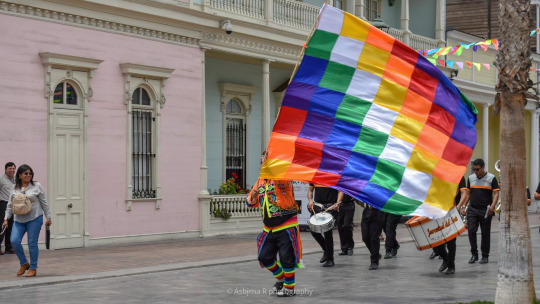#wiphala
Explore tagged Tumblr posts
Text

Johan Samboni
« Cúreme esta herida colonial »
Risografía, 2023
#Johan Samboni#Cali#Colombia#colombian art#risograph#arte#art#arte latinoamericano#wiphala#colonialism#colonial violence
12 notes
·
View notes
Text


Historical Flag Wars: Round 3, Bracket 3
8 notes
·
View notes
Text


A Wiphala is a square emblem commonly used as a flag to represent some native peoples of the Andes. This one is the Wiphala of Qullasuyu which Bolivia officially adopted in 2009 as a variant flag of the country.
3 notes
·
View notes
Text










Los antecesores *w*
#countryhumans#latinoamérica#imperio Inca#imperio brasileño#confederación Perú-boliviana#wiphala#Maya#Río de plata#confederación de Argentina
5 notes
·
View notes
Text
"The Wiphala (Quechua pronunciation: [wɪˈpʰala], Spanish: [(ɡ)wiˈpa.la]) is a square emblem commonly used as a flag to represent some native peoples of the Andes that include today's Peru, Bolivia, Chile, Ecuador, northwestern Argentina and southern Colombia.
Regional suyu wiphalas are composed of a 7 × 7 square patchwork in seven colors, arranged diagonally. The precise configuration varies based on the particular suyu represented by the emblem. The color of the longest diagonal line (seven squares) corresponds to one of four regions the flag represents: white for Qullasuyu, yellow for Kuntisuyu, red for Chinchaysuyu, and green for Antisuyu. Indigenous rebel Túpac Katari is sometimes associated with other variants.[citation needed]
The 2009 Constitution of Bolivia (Article 6, section II) established the southern Qullasuyu Wiphala as the dual flag of Bolivia, along with the red-yellow-green tricolor"
Actually saw this one recently, glad to find out what it is.
0 notes
Text
youtube
Music video to "Wiphalas off planet" by Cochabamba, Bolivia-based minimal cyberpunk synth act Retrovisor
#cyberpunk#minimal synth#synthpunk#indigenous futurism#Retrovisor#Wiphalas off planet#singles#music video#music#Bolivian#South American#Cochabamba Bolivia#Bolivian band#Bolivian music#indigenous#Youtube
3 notes
·
View notes
Text
Please reblog for a larger sample size!
If you know history and curiosities of Bolivia, please tell us and I'll share!
201 notes
·
View notes
Text

After winning Bolivia's presidency and in the wake of Bolivia's constitutional reforms, discussions of changing the flag were engaged. Evo Morales appeared at a football match with the following flag on his jersey in October 2006, made of the Bolivian colors crossed by the wiphala. In the end, no change was made.
52 notes
·
View notes
Text
me encantan las conglomeraciones o marchas de izquierda en este país porque siempre tenés ocho mil banderas del Frente Amplio, mil quinientas de la ya extinta URSS, cuatrocientas LGBT+, un par de wiphalas, dos o tres del país vasco, cuatro de carne dos de choclo una de choclo
15 notes
·
View notes
Text


Historical Flag Wars: Round 2, Bracket 5
8 notes
·
View notes
Text
"you can't just headcanon characters from community and pretend they're argentinean-" FUCK YOU. anyway🇦🇷🇦🇷🇦🇷🇦🇷
esto va para mis 5 mutis argentinos que les gusta community

BRITTA
(yo creo que si fuese 🇦🇷 se llamaría agustina)
-voto a bregman en la primera vuelta y en la segunda no votó porque la terminaron echando del colegio
-obsesión con los palitos de la selva
-se la pasa escuchando fuerza natural de gustavo cerati (jeff tiene las bolas al plato)
-le puso el nombre de evita perón a una de sus gatas
-fan #1 de mafalda
-no ve gran hermano porque le parece que es "un cruel experimento social" pero sube tweets de furia
-rolinga
-dice ATR (es una vieja queriéndose hacer la joven)
-tiene una banda de imanes en la heladera con la bandera wiphala
-el termo para el mate lleno de stickers
-dice "ah, re" en vez de "ahre" (de nuevo, vieja haciéndose la joven)

ANNIE
-siempre iba abanderada en el colegio y se enojaba cuando le tocaba llevar la bandera de buenos aires en vez de la nacional
-obsesión con miranda! fuerte. se hace escenarios en su cabeza
-OTRA FAN DE EVITA MÁS
-tiene todos los separadores de carpeta de mafalda
-compra cosas de todomoda religiosamente (sobretodo las lapiceras)
-cuando está haciéndose la pobrecita y finge que está al borde del llanto habla tipo "CHICOS OSEA NO DA TIPO CORTE YO SOY RE BUENA MAL Y USTEDES-"
-dice "gordi" pero no con voz de milipili
-hace títulos con resaltadores pasteles como los de tik tok
-ella SIEMPRE iba de dama antigua

ABED
-MOOOOOOOYYY fan de los simuladores y el cine argentino en general
-no ve fútbol, pero es de independiente porque troy es de independiente
#community#community nbc#nbc community#abed nadir#britta perry#annie edison#argentina#argieblr#argie tag#argieposting#🇦🇷
48 notes
·
View notes
Text

“La Wiphala es un símbolo, no una bandera, y representa a la Pachamama, el cosmos, los animales, las plantas, las piedras, los runas (hombres), la vida en armonía”
Para comprender su significado primero debemos referirnos a la Unancha, que es el símbolo que ostenta los colores del arco iris, en líneas horizontales”.
“En el devenir de la cosmovisión andino amazónica ocurre un hecho sagrado: el cruce de dos arcoíris, arcoíris macho y arcoíris hembra, la dualidad, pilar de nuestra cosmovisión”, expresan. “Esta dualidad, complementariedad de los opuestos, en su cruce, lleva a la evolución, al crecimiento, a la fertilidad y a la sabiduría. De este entrecruce de k´uichi (arcoíris) surge la Wiphala”.
La Wiphala está formada por 49 cuadrados de igual tamaño -por lo cual su forma es cuadrada- y cada color tiene un significado. Los amautas lo transmiten así:
Rojo: es el contacto con la Pachamama; representa a lo tangible, el Kay Pacha, a los Runas (hombres andino amazónicos), hijos de la Tierra; representa a la raíz ancestral, a la identidad. Al desarrollo cultural y a la cosmovisión indígena originaria, saberes de la Tierra y del Cosmos transmitidos por los Apus y los Ancestros.
Naranja: representa a la memoria oral de nuestra cultura, a los quipus, los telares, los yachay wasi (escuelas, casas del saber), a los ayllus (comunidades), a la medicina ancestral y a la sanación del cuerpo físico, psicológico y espiritual.
Amarillo: representa al Nunaq, Espíritu Ancestral que está en todas las cosas; a las cuatro virtudes del hombre andino: Munay (amor incondicional), Yachay (sabiduría), LLank´ay (trabajo alegre y con pasión) y Kamay (creatividad). Y a la dualidad de energías, qhari – warmi, opuestos complementarios, equilibrio que produce vida.
Blanco: representa a la evolución, al desarrollo intelectual, a la ciencia y la técnica que acompañan los procesos de la naturaleza, al buen vivir. Es el desarrollo personal que no se concibe si no es también comunitario. También representa al trabajo artesanal y al ayni (reciprocidad).
Verde: representa a la allpamama (naturaleza), a los frutos de la tierra, el trabajo del campo, a la economía comunitaria autosuficiente, a la abundancia de alimentos, de minerales, a Yaku Mama (Madre Agua).
Azul: representa al Hanan Pacha, mundo cósmico, al universo, entidades del Cosmos, energía sami (sutil) y energía jucha (densa), energías cósmico telúricas, a la Chakana (Constelación Cruz del Sur), al sistema Matemático fractal.
Violeta: representa a los Ayllus, Markas y Llajtas (comunidades, regiones y naciones), al Inka como la expresión de la evolución y el poder político y comunitario del Tawantinsuyu; representa a todas las organizaciones comunitarias sociales de desarrollo y dirección gubernamental.
Si se unen cuatro Wiphalas en un centro común con un determinado alineamiento de colores, se forma la Chakana (Chaka Hanan, Cruz del Sur), puente al mundo espiritual, al Cosmos.
Historiadores ubican el origen de la Wiphala en comunidades del Lago Titicaca, en el actual límite entre Bolivia y Perú, las cuales identificaban sus balsas de totora con insignias con los colores del arcoíris. También se hallaron restos de un estandarte con características similares en la actual costa peruana del océano pacífico con una antigüedad de 800 años. Si bien la Wiphala fue utilizada históricamente por las comunidades andino amazónicas, “posteriormente fue tomada por muchas comunidades indígenas de distinto origen que se sintieron representadas con este emblema de lucha por los derechos de los pueblos originarios, hasta llegar a todas las comunidades indígenas del Abya Yala (América)”, afirman los amautas.
Pero sabemos que cada Pueblo o Comunidad tiene su SIMBOLO, pero la Wiphala fue adoptada por varios Pueblos y la vemos en las Marchas.
Incluso, los miembros del Consejo de Amautas Indígenas del Tawantinsuyu van más allá y aseguran que NO hace falta pertenecer a un pueblo originario para sentirse representado por la Whipala.
“En este nuevo Pachakutyk (ciclo cósmico de 500 años de luz) se han abierto a toda la humanidad las puertas del conocimiento, el sentir y la sabiduría que en un principio se originó en los runas (hombres de origen andino amazónico)”, señalan, y agregan que “todos los que nos consideramos hijos de Pachamama y vivimos de acuerdo a sus procesos naturales, somos indígenas sin diferencias de color de piel, de cabellos, ojos o vestimenta. La Unancha y la Wiphala nos representan y nos hermanan en todos los extremos del Abya Yala (América) y del mundo. Donde exista una Wiphala o una Unancha estará representado el amor y el respeto al universo, a Pachamama, a los animales, a las plantas, a la tierra, a las comunidades y a la allpa mama (naturaleza)”.
Fuente: Libro Wiphala Wanka
PukioSonqo
Am@lia Vargas
13 notes
·
View notes
Text
Октябрьская Революция 2024

DeviantArt Weasyl InkBunny Itaku
PORTUGUÊS Em 1917, a União Soviética iluminou o destino do proletariado do mundo. Depois disso, outres camaradas também reescreveram seu próprio destino: China, Coreia, Vietnã e Cuba. Infelizmente, a URSS desapareceu. Mesmo assim, ainda hoje podemos ver sua vitória: com o poder do proletariado, pode-se chegar até ao espaço. Nesta arte, desenhei bandeiras de movimentos populares da América Latina: o movimento sandinista da Nicarágua, o movimento zapatista do México, a Wiphala dos povos dos Andes, o movimento 26 de julho de Cuba, o movimento Esquerda Revolucionária do Chile, e o movimento 8 de Outubro do Brasil. Em russo, está escrito "a revolução de vocês ilumina a nossa luta". Pra representar a URSS, desenhei um cachorro parecido com a Strelka, e coloquei o chapéu soviético. Em russo, Союз é uma palavra masculina. Por isso, o cachorro é homem. Essa onça representa a América Latina. Como a onça é um animal das Américas, ela simboliza os povos indígenas, e o cabelo simboliza a população negra. Em português e castelhano, "América Latina" é uma palavra feminina. Por isso, a onça é mulher.
CASTELLANO En 1917, la Unión Soviética iluminó al destino del proletariado del mundo. Después de eso, más camaradas también reescribieron su propio destino: China, Corea, Vietnam y Cuba. Lastimosamente, la URSS desapareció. Todavía, incluso hoy podemos ver su victoria: con el poder del proletariado, se puede alcanzar hasta en el espacio. En esta arte, dibujé banderas de movimientos populares de Latinoamérica: el movimiento sandinista de Nicaragua, el movimiento zapatista de México, la Wiphala de los pueblos andinos, el movimiento 26 de julio de Cuba, el Movimiento Izquierda Revolucionaria de Chile, y el movimiento 8 de Octubre de Brasil. En ruso, se le "su revolución ilumina nuestra lucha". Para representar a la Unión Soviética, dibujé un perro semejanta a Strelka, y le puse el sombrero soviético. En ruso, Союз es una palabra masculina. Por eso, el perro es hombre. El tigre representa a Latinoamérica. Como el yaguar es un animal de las Américas, ella simboliza a los pueblos originarios, y su pelo simboliza a la población negra. En portugués y en castellano, "América Latina" es una palabra femenina. Entonces, el tigre es mujer.
GUARANI Ary 1917-pe, Joaty Soviétiko omoendy mba'apohára raperã ko yvy ape arigua. Upéi, ambue angirũ avei ohaijey haperã: Chína, Koréa, Vietnã ha Kúva. Angai, URSS okañýra'ekue. Upéva jepe, ojehecha hína ág̃a avei Soviétiko rekoaguyjei: mba'apohára mbaretére, ikatu jahupyty arapýpe avei. Ko ta'angápe, amoha'anga tetãygua jeku'e poyvikuéra Latinoamerikaygua: FSLN Nicaragua-ygua, Zapatista México-ygua, Wiphala Andes ypykuéra rehegua, jeku'e 26 de Julio Cuba-ygua, MIR Chile-ygua, ha jeku'e 8 de Outubro Brasil-ygua. Rrusiañe'ẽme, ojehai "pene ñepu'ãmba omoendy ore ñorairõ". Amoha'anga jagua ojoguáva Strelka-pe ahechauka hag̃ua Soviétiko Joaty. Amoĩ hese avei soviétiko akangao. Rusoñe'ẽme, Союз ha'e kuimba'eñe'ẽ. Upévare, jagua ha'e kuimba'e. Jaguarete omoha'anga Latinoamérika. Jaguarete ha'e Amerikaygua, ha upévare ohechauka avei ypykuéra, ha hi'áva ohechauka kambakuéra. Portugeñe'ẽme ha karaiñe'ẽme, "América Latina" ha'e kuñañe'ẽ, ha upévare jaguarete ha'e kuña.
日本語 1917年、��ビエト連坊の同市は世界の労働者の運命を照らし出した。その後は他の同市も自分の運命を書き直した:中国とか朝鮮とかベトナムとかキューバとか。残念ながら、ソ連は消えてしまった。それでも、今まではソ連の勝利が見える:労働階級の力で、宇宙までも届ける。この絵には、ラテンアメリカの大衆運動のフラグを描いた:ニカラグアのサンディノ主義者とかメキシコのサパタ主義者とか南米のアンデスの民族のウィパラとかキューバの7月26日運動とかチリの革命的な左運動とかブラジルの10月8日運動。ロシア語の文字は「君たちの革命は僕達の戦いを照らしている」と書かれてる。ソ連をあらわすために、ストレルカのような犬を描いて、ソビエト防止も描いた。ロシア語でСоюзは男的な名詞だから、犬は男だ。そのジャガーはラテンアメリカとあらわしてて、ジャガーはアメリカの動物だから、土着民の意味があって、髪は黒人という意味があって、ポルトガル語とスペイン語でAmérica Latinaとは女的な名詞だから、ジャガーは女なんです。
ESPERANTO 1917-jare, Sovetunio lumigis la estontecon de la proletaro de la mondo. Poste, aliaj kamaradoj reskribis sian propran sorton: Ĉinio, Koreio, Vietnamo kaj Kubo. Bedaŭrinde, Sovetunio malaperis. Tamen, hodiaŭ ni povas vidi ĝian venkon: tra la povo de la proletaro, oni povas atingi eĉ la kosmoson. En tiu arto, mi desegnis flagojn de movadoj popolaj de Latinameriko: la FSLN de Nikaraguo, la Sapatisma movado de Meksiko, la Ŭiphalo de la popoloj de la Andoj, la movado "26 julio" de Kubo, la Movado Revolucia Maldekstro, de Ĉilio, kaj la movado 8 Oktobro de Brazilo. Ruse, skribatas "via revolucio lumigas nian lukton". Por reprezenti la Sovetunion, mi desegnis hundon, kiu similas al Strelka, kaj metis la sovetan ĉapelon. Ĉar Союз estas iĉa vorto ruse, la hundo estas iĉa. La jaguaro reprezentas la Latinamerikon. Ĉar la jaguaro estas amerikana besto, ĝi montras la indiĝenaron, kaj ĝia haro montras la nigraron. Portugale kaj hispane, "América Latina" estas ina vorto, kaj tial la jaguaro estas ina.
#furry#anthro#polyglot#canine#dog#feline#jaguar#ussr#soviet#socialist#communist#latinamerica#history
4 notes
·
View notes
Text

An indigenous man waves the Wiphala of the Qullasuyu* as part of a celebratory parade down Baquedano, Iquique. It was celebrating the promulgation of indigenous law №19.253.
It's hard to believe it's been half a decade since I've been home to Iquique and my querida Pampa.
*The Qullasuyu refers to the southeastern "corner" of the Incan state and roughly encompasses (using modern borders), Tacna, Perú, Chile north of the Río Maule, and Bolivia.
Iquique and, in particular, Alto Hospicio has retained a large Quechua/Aymara population owing to a recent flux of migrants from Bolivia as well as the pre-existing population in and of the Altiplano.
15 notes
·
View notes
Text
in case anyone was wondering, the best flag in the whole world is the wiphala:

3 notes
·
View notes
Text
RULO GODAR Y NACIÓN WIPHALA presenta TRES INVIERNOS
http://dlvr.it/T8y5Rg
0 notes